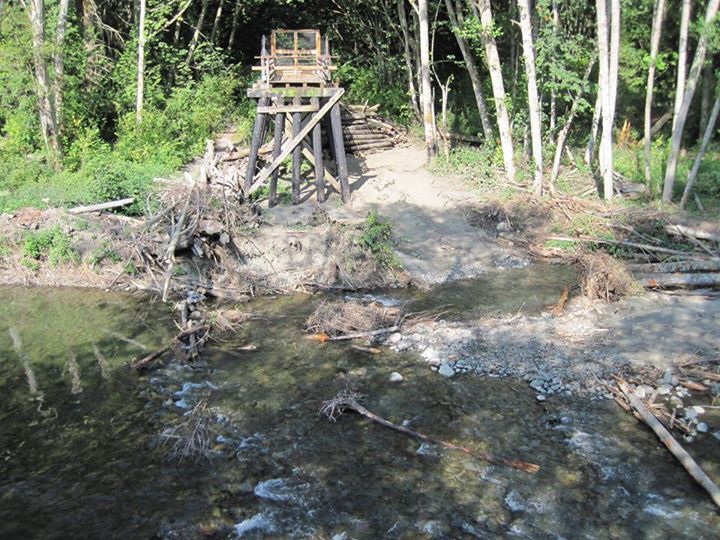
FAQ: Railroad Bridge Trestle Replacement – August 3, 2015
For more information contact Annette Nesse, Chief Operations Officer, Jamestown S’Klallam Tribe
by email at anesse @jamestowntribe.org or by phone at 360-681-4620
In February 2015, the Railroad Bridge Trestle across the Dungeness River was damaged. Since then, the Tribe and many of its partners have been working in consideration of both fish and humans to address the broken link across the river. This is Trust property, owned by the Tribe, which we allow the public to access for recreational purposes.
What has been done so far? Since February, the Tribe, which owns Railroad Bridge Park, the Howe Bridge Truss, and trestle, has sought funding and worked with design engineers to determine the best fix for the trestle, which was built in the 1960s.
What is the best fix? The best fix for the damaged Railroad Bridge Park Trestle has been determined to be a total replacement. This option addresses Tribal transportation infrastructure goals and provides for river processes, meeting important salmon habitat goals as well. Along with the engineering firm, Otak, an Advisory Group consisting of representatives of the Tribe, the Dungeness River Audubon Center, the River Center Board, the Peninsula Trails Coalition, Washington Department of Fish and Wildlife, the North Olympic Salmon Coalition, the North Olympic Peninsula Lead Entity for Salmon and Clallam County, chose the preferred alternative. This design and engineering work was paid for with a $172,000 grant from the Washington State Recreation & Conservation Office Salmon Recovery Fund Board (RCO-SRFB).
What just happened last weekend? In preparation for the full replacement, and in order to avoid conflict with pink and chinook salmon spawning in the project area (expected to begin by mid-August), five pile bents that were in contact with the river channel were removed on August 1st and 2nd. This part of the project was paid for with Tribal funds.
What permitting was required for last weekend’s work? Prior to undertaking this work in the river, the Tribe conducted its well-established internal environmental review process (according to the Tribal Environmental Policy Act or TEPA), used to identify and mitigate potential environmental impacts. A Determination of Mitigated Significant Impact was issued by the Responsible Official for removal of the damaged pilings and bents only. The remainder of the work will be conducted under normal NEPA and other review and permitting processes.
Why did it happen in August, when the fish are starting to migrate up river? From a biological perspective, the fish window for work in contact with the Dungeness River channel is very short. Until mid-July steelhead (listed as Threatened under ESA) fry are emerging from the gravel. Fry emergence is a sensitive life stage and so work must wait for that period to finish. Then between mid-July and mid-August there is a brief time slot where instream work is less harmful. When funding for the project was guaranteed, the Tribe was very anxious to complete the in-river work before any spawning in the project area. The spawning is generally considered to be mid-August but the sooner work could be completed, the better. We were able to avoid a critical fish lifecycle period and conduct the work with minimal impact.
Why is this taking so long? Much of the work done by the Tribe and our partners to date is invisible because of the complexities of modifying a large-scale and environmentally sensitive river crossing connected to a Registered National Historic Property. A replacement bridge over habitat of four listed salmon species, open to public recreation and school programs, requires a lot of non-construction work such as: securing funding estimated approximately $2 million, completing the engineering work and obtaining permits.
When will the trestle be replaced? Final permits for the rehabilitation of the trestle require NEPA and Section 106 reviews, which are in progress. It is expected that work will begin in late August. Total replacement of the trestle will remove the 38 creosote timber pile bent supports from the river bed to allow the river to move more naturally through this reach and create high quality salmon habitat. It will also restore the Olympic Discovery Trail Dungeness River bike/pedestrian crossing with a trestle of modern materials that is structurally sound.
Where did the funding come from? Funding of $1.53 million for the replacement project came from a Recreation and Conservation Office Salmon Recovery Funding Board (RCO-SRFB) grant. Several other sources of funding will also be used to build the project including Tribal insurance proceeds, Tribal transportation funding, and a contribution from the Peninsula Trails Coalition.

